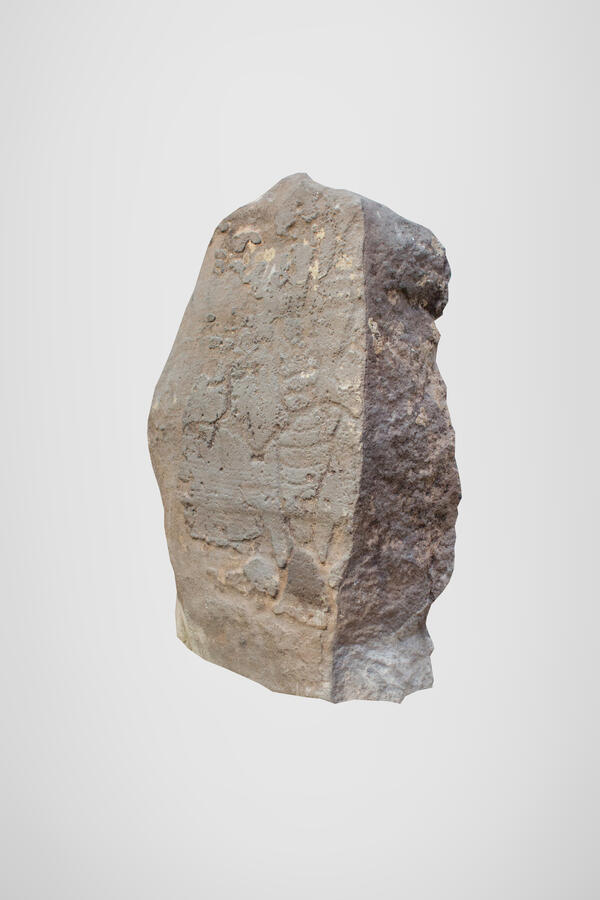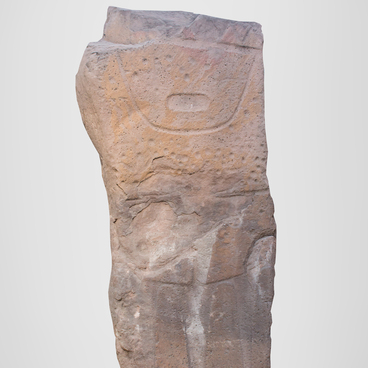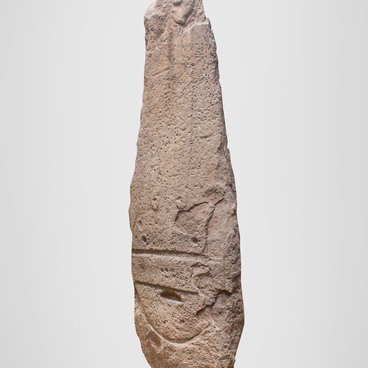Archaeologists found the stela of the Tagar mound near the village of Pulankol in the Askiz district of the Republic of Khakassia. The mound is located not far from the buildings of the village among the Tagarsky burial ground. The sandstone slab presented in the museum was in the middle of the southeastern side of the fence. Archaeologist Leonid Kyzlasov brought it to the Khakass Regional Museum of Local History in 1981.
The left side of a rare anthropomorphic image has been preserved on the smooth surface of the stone. The right side of the slab was broken off and lost in antiquity, even before the construction of the mound. Initially, the image was located in the center of the stone, which once stood separately on the banks of the Kamyshty River. A humanoid deity with an oval head, ears and horns is carved on the slab with narrow, shallow lines. The body of the statue has a tapering waist, a chest covered with transverse half rings, and hips. In his right hand, the deity holds a small animal, the left is raised up. Horizontal lines are carved under the right hand. Another line goes down from the left hand. There are protrusions on both sides of the thighs. The eyes of the deity are schematically outlined in semicircular arcs. The transverse line divides the mask into two parts in the middle; the mouth is indicated at the bottom.
Unfortunately, the lower part of the image has not been preserved, so only the front part of the animal with the horns facing back can be seen. Perhaps this is an image of a roe or a goat. A part of the mask is crossed out by an embossed line running from above, across which another wriggling line runs. The researchers suggest that this part of the drawing was applied later than the main image.
According to scientists, the deity depicted on the stela was revered in ancient times as the master of these grounds and animals inhabiting the surrounding lands and taiga forests. The personality of the deity is depicted largely conditionally, but the drawings of the animals are made relatively realistically.
According to the Khakass, detailed images of potential prey and the rituals associated with them could help in hunting. Most often, however, domestic animals, such as horses, were depicted on the stone. A profile outline image is typical, and sometimes the silhouettes were decorated with simple geometric patterns.
The left side of a rare anthropomorphic image has been preserved on the smooth surface of the stone. The right side of the slab was broken off and lost in antiquity, even before the construction of the mound. Initially, the image was located in the center of the stone, which once stood separately on the banks of the Kamyshty River. A humanoid deity with an oval head, ears and horns is carved on the slab with narrow, shallow lines. The body of the statue has a tapering waist, a chest covered with transverse half rings, and hips. In his right hand, the deity holds a small animal, the left is raised up. Horizontal lines are carved under the right hand. Another line goes down from the left hand. There are protrusions on both sides of the thighs. The eyes of the deity are schematically outlined in semicircular arcs. The transverse line divides the mask into two parts in the middle; the mouth is indicated at the bottom.
Unfortunately, the lower part of the image has not been preserved, so only the front part of the animal with the horns facing back can be seen. Perhaps this is an image of a roe or a goat. A part of the mask is crossed out by an embossed line running from above, across which another wriggling line runs. The researchers suggest that this part of the drawing was applied later than the main image.
According to scientists, the deity depicted on the stela was revered in ancient times as the master of these grounds and animals inhabiting the surrounding lands and taiga forests. The personality of the deity is depicted largely conditionally, but the drawings of the animals are made relatively realistically.
According to the Khakass, detailed images of potential prey and the rituals associated with them could help in hunting. Most often, however, domestic animals, such as horses, were depicted on the stone. A profile outline image is typical, and sometimes the silhouettes were decorated with simple geometric patterns.



